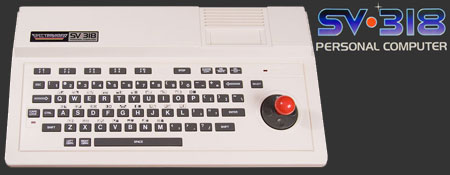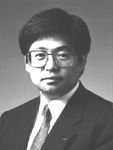 SpectraVision was founded in 1981 by Harry Fox and Oscar Jutzeler, two Swiss clock/watch makers who had moved to North
America in the 1950s. SpectraVision was a distributor of
computer games, not a software house. They had several
contracts with external developers writing the games. Their main products
where gaming cartridges for the Atari 2600 VCS, SpectraVision was founded in 1981 by Harry Fox and Oscar Jutzeler, two Swiss clock/watch makers who had moved to North
America in the 1950s. SpectraVision was a distributor of
computer games, not a software house. They had several
contracts with external developers writing the games. Their main products
where gaming cartridges for the Atari 2600 VCS,
 Colecovision and
Commodore VIC-20. Colecovision and
Commodore VIC-20.
They also made the world's first ergonomic joystick,
the Quickshot. It was developed by Harry Fox and Peter
Law, patented in 1982 (U.S.
Patent D271220).
The Quickshot was a huge success all over the world. It
was followed by a number of other variations, all using the
Quickshot brand.
 In
late 1982 the company was renamed to Spectravideo
due to a naming conflict with OnCommand's Hotel TV system
called SpectraVision. After the huge success with the
Quickshot joystick, Spectravideo was ready for the next step. In
late 1982 the company was renamed to Spectravideo
due to a naming conflict with OnCommand's Hotel TV system
called SpectraVision. After the huge success with the
Quickshot joystick, Spectravideo was ready for the next step.
In january 1983, at the Winter CES show in Las Vegas,
Spectravideo lauched
both the Spectravideo CompuMate, and the SV-318 computer.
The CompuMate was a hardware add on for the ATARI 2600 game
console, turning it into a real computer.
It provided a touch keyboard, cassette recorder connection and
Microsoft Basic.
Their first real computer was the
Spectravideo SV-318. It was their
own design, based on a Z80 processor, 16k RAM, TMS9918A graphics
chip and AY-3-8910 sound chip. Microsoft provided the Basic interpreter,
called the SV Extended Basic. They also developed a special
version of DOS called MSX-DOS.
Microsoft was late delivering the Basic interpreter, causing
Spectravideo to miss the important holiday sale period.

The SV-318 was soon followed by the
SV-328, a more powerful version with 64k
RAM, full stroke keyboard and a numeric keypad, replacing the
joystick. The SV-328 also had CP/M support, licensed from
Digital Research.
Spectravideo showed working models of the SV-328 at the 1983
Summer CES show in Chicago.
 The
SV-318/328 was a combined effort of Spectravideo in the US
(management & marketing), Bondwell in Hong Kong (manufacturing)
and
ASCII
Corporation in Japan (systems software). ASCII also was
the Microsoft representative in Japan at that time. The
SV-318/328 was a combined effort of Spectravideo in the US
(management & marketing), Bondwell in Hong Kong (manufacturing)
and
ASCII
Corporation in Japan (systems software). ASCII also was
the Microsoft representative in Japan at that time.
ASCII�s president Kazuhiko Nishi (also known as Kay Nishi) saw
the potential in the Spectravideo computer system. He
wanted to make a world standard for home computers out of the
SV-328 design, called the MSX standard.
Spectravideo agreed with this, and ASCII started to make some
small changes of the design.
In 1984 Spectravideo licensed this
hardware technology to Microsoft.
This also gave Spectravideo a much needed financial boost as
they where in rather severe financial trouble.
The MSX vision was creating a world standard for home computers.
There
are
two explanations for the letters in MSX: "Machines with
Software Exchangeability", and "Microsoft Software Exchange".
MSX
would use a common hardware design, allowing the same software and
peripherals to be used on machines from different manufacturers.
Kazuhiro Nishi
also teamed up with his friend Bill Gates from
Microsoft. In the beginning Bill Gates was enthusiastic about
the MSX project. But as time went by, he realized that the MSX
could be a threat to the PC and the MS-DOS business Microsoft
was doing with IBM.
Check out this interview with Bill Gates and
Kazuhiro Nishi on YouTube.
 The
Spectravideo SV-328 was the prototype for the
MSX design. But there were some small differences, making the
318/328 incompatible with MSX. Some of the
differences where the BIOS, I/O ports and disk format. But
this didn't stop Spectravideo from using the MSX story in their
marketing of the 318/328. Some of the marketing material for the
SV-318/328 is more or less telling that the computers will run
MSX software. The
Spectravideo SV-328 was the prototype for the
MSX design. But there were some small differences, making the
318/328 incompatible with MSX. Some of the
differences where the BIOS, I/O ports and disk format. But
this didn't stop Spectravideo from using the MSX story in their
marketing of the 318/328. Some of the marketing material for the
SV-318/328 is more or less telling that the computers will run
MSX software.
Here's a quote from the 1983
SV-318 flyer:
"When you buy a SV-318, you will not only able to use all
Spectravideo's own software and hardware - you'll also be able
to take advantage of all the remarkable new equipment that will
be coming from other MSX participants.". Well, it doesn't
say MSX software compatible, but its close enough. The
flyer also had the MSX logo next to the computer.
The same was true about the
SV-328 flyer.
Many
customers where confused by this.
The
SV-328 follow up, the 1984/85 SVI-728 where their first fully MSX
compatible computer. |
|
 The
company was named Spectravideo International in 1984.
Spectravideo was now represented all of Europe, US, Australia,
South Africa and Israel. The
company was named Spectravideo International in 1984.
Spectravideo was now represented all of Europe, US, Australia,
South Africa and Israel.
This also led to a change
of all the model names, using
SVI in front of the model numbers.
Rumors are saying
the model numbers were picked based on their goodness in
Chinese numerology. That is why many of them contain the number
8.
Spectravideo also revised the 318 and 328 hardware. Among
the changes was a single ULA chip instead of several TTL chips,
reducing the motherboard footprint and cost.
They also put the TV modulator inside the machine.
The revised machines where called the SVI-318MKII and SVI-328MKII.
In late 1984 Spectravideo launched their fully MSX compatible
computer, the Spectravideo SVI-728.
Spectravideo had then sold over 25.000 computers worldwide.
Spectravideo had a fairly good success in Europe and other parts
of the world, but their US sales was poor. Some was
blaming bad distribution, and limited visibility in the stores.
Their financial situation wasn't in good shape either.
Spectravideo closed its US operations in 1985.
This was a decision taken by Bondwell Holding, Spectravideos
manufacturing partner and major shareholder.
Bondwell moved everything to Hong Kong.
The next product from Spectravideo was the SVI-738 X'Press,
a MSX compatible computer with integrated floppy drive and
80-column support.
That was followed by a PC/MSX2 hybrid, the SVI-838
XPress'16.
Spectravideo left the MSX camp in 1986, and concentrated on
PC compatible computers, the Spectravideo
SVI-256 and the SVI-640FH/FF.
For a brief moment in time, Spectravideo claimed a monopoly on
MS-DOS computers in the US. The stock went up and the insiders
sold out.
Bondwell also had their own Bondwell branded PC's.
The Z80 based Bondwell 2, and the Intel 8088 based
Bondwell 8 beeing two of them.
After a while Bondwell
abandoned
the Spectravideo name, and started to use the Bondwell brand for
all of its computers.
The Spectravideo brand was later sold to a UK based company, and
the
QuickShot brand sold to Tomei International.
 Some of you might wonder what happened to the founders of
Spectravideo.
In the late eighties Harry Fox worked for Vendex Pacific,
developing US sales through his company Megasonic. Vendex
Pacific was a Hong Kong based computer company
selling IBM compatible PC's (manufactured by Samsung) with a
user friendly software package called HeadStart. Vendex Pacific
was later sold to Philips USA, and renamed to Vendex Technnology
Inc. Some of you might wonder what happened to the founders of
Spectravideo.
In the late eighties Harry Fox worked for Vendex Pacific,
developing US sales through his company Megasonic. Vendex
Pacific was a Hong Kong based computer company
selling IBM compatible PC's (manufactured by Samsung) with a
user friendly software package called HeadStart. Vendex Pacific
was later sold to Philips USA, and renamed to Vendex Technnology
Inc.
Fox was involved in various multimedia projects during the early
nineties, among them Multimedia Publishers Group and Futurevision.
During the mid nineties he was a director at Virtual Communities
Inc, a company creating solutions for web-based communities.
Harry Fox also played a role in the dotcom wave in the late
nineties. He was the cofounder and CEO of Versaware, a company
specializing in E-Book's. He announced his resignation from
Versaware in 2001, but remained a major shareholder.
Oscar Jutzeler however, went back to his roots. He still has his watch shop, located just a
block or so from where Spectravideo Canada was.
The Spectravideo brand was later used by a UK based
company called
SpectraVideo Plc, former known
as Ash &
Newman.
It was founded, in 1977, and took the Spectravideo name in 1988.
They sold a range of Logic3 branded products for
computers, game consoles and Apple iPOD.
Update 11/06/24:
Logic3 was formally dissolved in 2016.
The end of the road for the Spectravideo brand, for now...
This story is work in progress.
The information is partly based on information Thomas Karlsson
collected from Spectravideo insiders.
I've also collected information from other
internet sources, as well as printed marketing material and
magazines* from the
early eighties.
The Spectravision/Spectravideo namechange must have been in
1982, not in 1983 as many other sources claims.
The Quickshot box has "(C) Spectravideo 1982" printed on it, and
the US Patent 271220 is filed
on nov.9th 1982, under the asignee: Spectravideo International
Limited.
If you have any corrections or more details, please drop
me an email:

* A fully searchable database
of 80's magazines can be found at:
http://www.atarimagazines.com/
All trademarks
(TM), trade names, services marks and logos referenced herein
belong to their respective companies. |